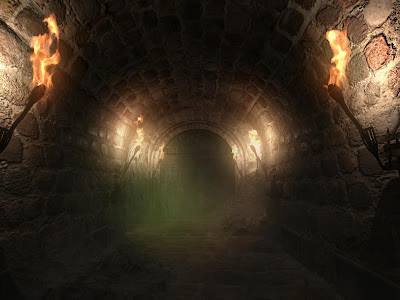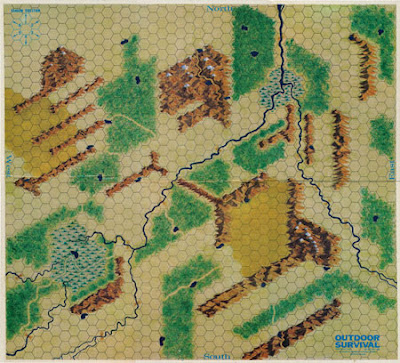
This will be my final post on Comma, Blank_, because I now have my own domain! All new posts can be found at:
www.PapersPencils.com
Comma, Blank_'s entire archive of RPG posts has been successfully ported over to the new site. I have also transferred each and every one of the post comments by hand, including links back to each commenter's profile, because I put a high value on the feedback you, my readers, leave for me. However, no new posts will be posted here after this one. And I will not be monitoring comments on this site any longer. So update your bookmarks, feed reader, or whatever it is you use to access my writings! I consider it a privilege to entertain my readers, and I would hate to lose even a single one of you in this move.This site has been of immeasurable value to me, and I must confess I'm sorry to leave it, even if I'll just be doing the exact same thing on the new site. Before I started this site, I was not very happy with my life. A quick peek at the first post on the blog, entitled "Worthlessness," (which is one of the few non RPG posts here, and will not be moving to the new site), might give you a bit of an idea of just how down on myself I was. Truth be told, that's not even the half of it. I was struggling through more emotional distress at the time than I want to bother talking about here. Suffice to say, my life was not going well, and I had very little hope that it would ever get better.
The blog trudged along lazily through August and September. I was aiming to put up 3 posts every week, but I was failing, which was business as usual for me. In my mind, it was a foregone conclusion that eventually I'd get bored of the blog, and go back to being an "aspiring writer," who thinks a lot about writing, but never actually does it. I felt shitty about myself, and to be honest, I should have felt shitty about myself. I have no pity for the faults in myself which are rooted in my own lack of will. During a moment of courage in early October, I decided I was going to push myself harder. I was going to get 15 posts done that month, I decided. On October 10th, 2011, while driving my girlfriend Morrie to the train station in the morning, I told her that I was going to try to put up 15 posts in October. She snickered."No you're not." she said flatly. The comment stung, and I think she sensed that. She quickly qualified her statement. "I mean, you'd have to do a post what...every night?"
Don't judge her harshly. It was an off-the cuff response which she has repeatedly apologized for in the time since. I almost didn't even mention that it was her who said it, but I want to make clear that this was the opinion of someone who matters to me. The comment stung. I got angry. I've heard a lot of writers say that a dismissive comment, or a rejection, is what motivated them to keep going. I never understood the sentiment until that day. As soon as I got to work I pulled a calendar off the wall and began marking off days. I figured I shouldn't write every day, since that would just burn me out. I would, instead, write every other day during the week, on a Monday-Wednesday-Friday schedule. I have the weekends off, so decided I should have plenty of time both to rest, and to write on Saturday and Sunday. By that schedule of 5 posts a week, I figured out that I could have 19 posts done by the end of the month. That was plenty. Over lunch that day I started working on Magically Generating New Adventures, which remains one of my most popular posts. I started keeping tally marks for how many posts I had for the month. I was going to prove Morrie wrong. I was going to hit 15 posts. I could even skip 4 days if I wanted to.I didn't want to.
 I kept to my schedule exactly. Even on Halloween, my favorite holiday, I was answering the door between writing paragraphs of The Problem With Feats. I tapped away at my keyboard despite a finger which I had severely burned on an ultraviolet light. Despite the fact that my hair kept getting in my face, since having it down was part of my costume. Despite the fact that I had already reached my 15-post goal. The goal didn't matter anymore. Proving Morrie wrong didn't matter anymore. I owe her a lot for that single insensitive comment, because without it I don't know if I would have managed to forge the self discipline which has allowed me to devote myself so fully to this writing project.
I kept to my schedule exactly. Even on Halloween, my favorite holiday, I was answering the door between writing paragraphs of The Problem With Feats. I tapped away at my keyboard despite a finger which I had severely burned on an ultraviolet light. Despite the fact that my hair kept getting in my face, since having it down was part of my costume. Despite the fact that I had already reached my 15-post goal. The goal didn't matter anymore. Proving Morrie wrong didn't matter anymore. I owe her a lot for that single insensitive comment, because without it I don't know if I would have managed to forge the self discipline which has allowed me to devote myself so fully to this writing project.I continued my 5-posts-a-week schedule through November, which proved harder. By the end of November I had decided two things. First, writing a Comma, Blank_ post five days a week was too much for me. I started to worry that I was going to burn out, so in December I officially dropped down to only one post over the weekend, bringing my work load down to only four posts per week. Second, I decided that it was time to devote myself more fully to the writing project. So, in early December, I did some budgeting, and some brainstorming, and registered the www.PapersPencils.com domain, and purchased two years of hosting. Yeah, I've been working on this for almost three months. What can I say? I'm a busy guy.
Since starting Comma, Blank_, I have missed only 2 posts, which were over the Christmas holiday. My life is better in countless ways. I feel like I'm improving myself a little bit with every word I write. And my readership is growing as well. During the month of February, there has not been a single day where traffic was lower than the corresponding day of the previous month. It kinda makes me want to continue using the old site until Wednesday just to see if the trend actually continues throughout the whole month. But, to be honest, it has been a serious pain in the ass to format everything post twice--once for Blogger, and again for Wordpress. I'm eager to be done with that. Besides, in 25 days of February, I've already surpassed the traffic during the 31 days of January by over 200 unique hits, and broken the 1000-hit-per-month barrier for the first time. And I don't intend to stop there. I've got so many plans for future projects and improvements--you have no idea.
So thank you, my readers, and everyone who has ever linked to me. Thank you to my friends on Twitter, and to my girlfriend Morrie. Thank you to -C of Hack and Slash for sending me several unique hits ever day, and to /tg/ for giving me years worth of scintillating conversation and inspiration, and to every RPG blog I've ever read which has given me an idea or caused me to question my preconceived notions. Thank you to my friends who play these tabletop RPGs with me, who have been very patient with me when I've allowed writing about games to distract me from running games. You all rock.
By the way, if you were wondering, this blog was called Comma, Blank_ because I originally envisioned it as a project "in between" the major projects of my life. The idea was that looking back, the stuff I worked on before this blog would be considered significant, and the stuff after this blog would be significant, but this blog was likely to be somewhat forgettable. That's what I thought at the time, anyway. Thus, this blog was the comma between the things I did in the past, and the things I would someday do in the future. Ironic that it ended up becoming a project which I used to redefine who I am. For three days, the blog was actually titled simply " ,_ " but I started to feel like too much of a hipster douche for my own taste.
I figured I ought to tell that story, since I likely won't get another chance.See you on the new site, friends!
-Nick "LS" Whelanwww.PapersPencils.com








